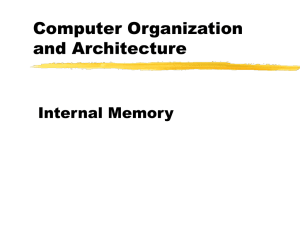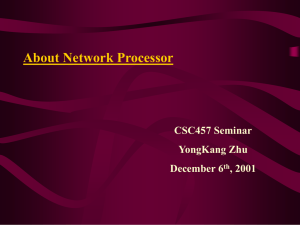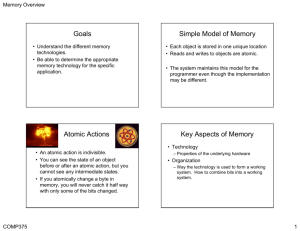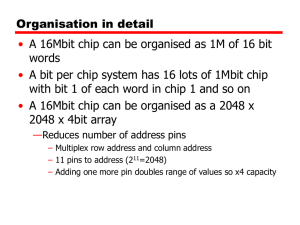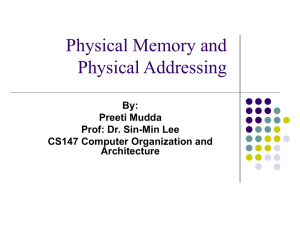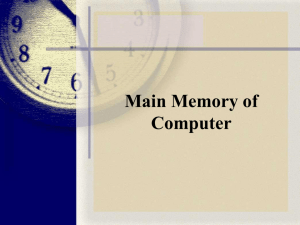Lecture 37
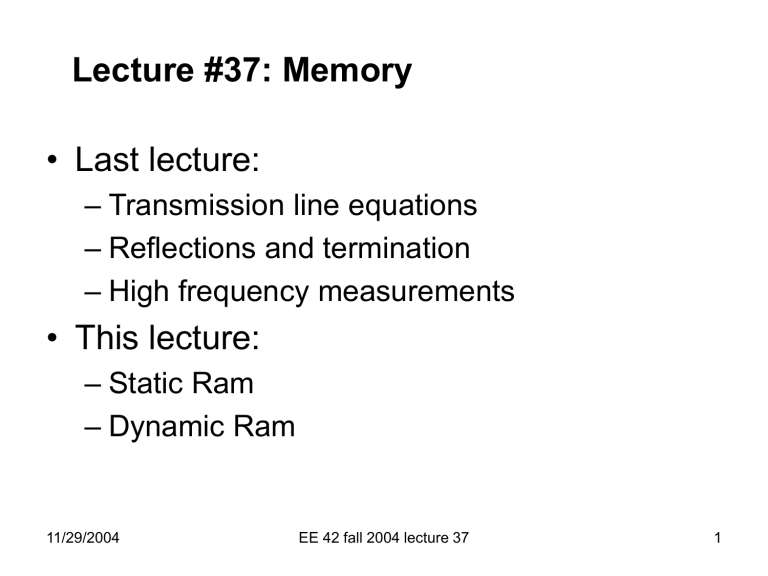
Lecture #37: Memory
• Last lecture:
– Transmission line equations
– Reflections and termination
– High frequency measurements
• This lecture:
– Static Ram
– Dynamic Ram
11/29/2004 EE 42 fall 2004 lecture 37 1
Memory types
• In addition to registers, there is usually a need in digital logic devices for a denser
(and therefore cheaper) means of storing information in larger amounts.
• The main memory types are known as
RAM (Random Access Memory) as contrasted with long shift registers from which information can only be extracted or added in sequence.
11/29/2004 EE 42 fall 2004 lecture 37 2
RAM
• In a RAM, an address is provided to a block of logic, along with an address strobe and a write signal line.
• The memory block then either reads a block of bits and puts it onto a bus, or writes the data from the bus into the indicated area of memory.
11/29/2004 EE 42 fall 2004 lecture 37 3
Types of memory
• SRAM (Static RAM) is a memory which is essentially an array of flip flops. It can be very fast, and is integrated with logic.
• DRAM (Dynamic RAM) is a dense memory which uses a single capacitor controlled by a switch to store a bit. Dram must be rewritten after a write, and must be refreshed periodically.
11/29/2004 EE 42 fall 2004 lecture 37 4
Other types of memory
• Read only memory (ROM) is a memory whose content is fixed at manufacture, and thus can only be read.
• Content addressable memory (CRAM) is memory which can be addressed, at least in part by its contents, rather than an address.
• E 2 memory (electrically erasable) is memory which can be read and written, but whose content is nonvolatile. Writing is often much slower than reading
11/29/2004 EE 42 fall 2004 lecture 37 5
RAM logical organization
Column Decoder
…
Read/Write
D
Q
Address lines
Memory array
Address strobe
Note that the number row decoder lines and column lines goes like the square root of the memory size
11/29/2004 EE 42 fall 2004 lecture 37 6
SRAM
• Cache uses SRAM : Static Random Access
Memory
– No refresh
– Size 6 transistors/bit
– Fast, can be optimized for speed or area reduction
– Compatible with dense logic, so can be integrated with microprocessors with no extra masks
11/29/2004 EE 42 fall 2004 lecture 37 7
Static RAM (SRAM)
• Six transistors in cross connected fashion
– Provides regular AND inverted outputs
– Implemented in CMOS process
11/29/2004
Single Port 6-T SRAM Cell
EE 42 fall 2004 lecture 37 8
SRAM cell
• Each cell of an SRAM is a pair of cross connected small inverters
• As long as power is supplied, the latch will hold the value.
• When the row line is held high, the outputs are driven with the contents of the memory.
• The latch is written by using a more powerful driver on the column lines to overcome the smaller transistors in the latch which forces the desired state.
11/29/2004 EE 42 fall 2004 lecture 37 9
DRAM
• Main Memory is DRAM : Dynamic Random
Access Memory
– 1 transistor
– Dynamic since needs to be refreshed periodically
(8 ms, 1% time)
– Addresses divided into 2 halves (Memory as a 2D matrix):
• RAS or Row Access Strobe
• CAS or Column Access Strobe
11/29/2004 EE 42 fall 2004 lecture 37 10
Dynamic RAM
• SRAM cells exhibit high speed/poor density
• DRAM: simple transistor/capacitor pairs in high density form
Word Line
C
.
.
.
Bit Line
Sense Amp
EE 42 fall 2004 lecture 37 11/29/2004 11
Basic DRAM Cell
• Planar Cell
– Polysilicon-Diffusion Capacitance, Diffused Bitlines
• Problem: Uses a lot of area (< 1Mb)
• You can’t just ride the process curve to shrink C (discussed later)
Capacitor
11/29/2004
Metal word line poly n
+ poly n
+
Inversion layer induced by plate bias
(a) Cross-section
SiO
2
Field Oxide
M1 word line
Diffused bit line
Polysilicon
Polysilicon plate gate
(b) Layout
Used Polysilicon-Diffusion Capacitance
Expensive in Area
EE 42 fall 2004 lecture 37 12
DRAM Operations
• Write
– Charge bitline HIGH or LOW and set wordline HIGH
• Read
– Bit line is precharged to a voltage halfway between HIGH and LOW, and then the word line is set HIGH.
Word
Line
– Depending on the charge in the cap, the precharged bitline is pulled slightly higher or lower.
– Sense Amp Detects change
C
.
.
Bit Line
• The signal is decreased by the ratio of the storage capacitance to the bitline capacitance
– Increase density => increase parasitic capacitance
Sense
Amp
– As geometries shrink, still need large bit capacitance
11/29/2004 EE 42 fall 2004 lecture 37 13
Advanced DRAM Cells
• Stacked cell (Expand UP)
11/29/2004 EE 42 fall 2004 lecture 37 14
Advanced DRAM Cells
• Trench Cell (Expand DOWN)
Cell Plate Si
Capacitor Insulator
Storage Node Poly
2nd Field Oxide
Refilling Poly
Si Substrate
11/29/2004 EE 42 fall 2004 lecture 37 15
DRAM logical organization
(4 Mbit)
11
Column Decoder
…
Sense Amps & I/O
D
Q
A0…A10
Memory Array
(2,048 x 2,048)
Word Line
• Square root of bits per RAS/CAS
11/29/2004 EE 42 fall 2004 lecture 37 16
Bit line
DRAM sense amp
+V enable enable
Both precharged to ½ V
Data out enable enable
EE 42 fall 2004 lecture 37 11/29/2004 17
DRAM sense amplifier
• The reason that DRAM is slow, is that a very small charge is captured on the capacitor, and the small voltage change on the line must be sensed.
V
Charge dumped to bit line
Precharge →
Sense amp decides 0 or 1
EE 42 fall 2004 lecture 37 time
11/29/2004 18
DRAM/SRAM tradeoffs
• By it’s nature, DRAM isn’t built for speed
– Response time dependent on capacitive circuit properties which get worse as density increases
• DRAM process isn’t easy to integrate into CMOS process
– DRAM is off chip
– Connectors, wires, etc introduce slowness
– IRAM efforts looking to integrating the two
• Memory Architectures are designed to minimize impact of DRAM latency
– Use dram for high density, store data which is used often in smaller, higher speed SRAM cache.
11/29/2004 EE 42 fall 2004 lecture 37 19
FLASH Memory
• Floating gate transistor
– Presence of charge => “0”
– Erase Electrically or UV (EPROM)
• Performance
– Reads like DRAM (~ns)
– Writes like DISK (~ms). Write is a complex operation
11/29/2004 EE 42 fall 2004 lecture 37 20
More esoteric Storage
Technologies?
• Tunneling Magnetic Junction RAM (TMJ-RAM):
– Speed of SRAM, density of DRAM, non-volatile (no refresh)
– New field called “Spintronics”: combination of quantum spin and electronics
– Same technology used in high-density disk-drives
11/29/2004 EE 42 fall 2004 lecture 37 21
Tunneling Magnetic Junction
11/29/2004 EE 42 fall 2004 lecture 37 22

